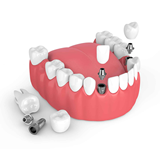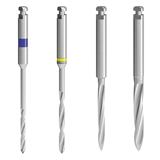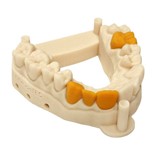He told MedicalSearch.com about the biggest issues facing the dental care industry in Australia over the next five years. The industry is currently suffering from a serious lack of dentists to cope with an increasing number of dental problems. In Part 2, he explains how these problems could be fixed in the future.
Who is mainly responsible for the lack of resources available?
It’s the Government’s responsibility - absolutely. It has a responsibility to provide the plan for the workforce to service the needs of the community, be that in dentistry, architecture, bridge building or for medical practitioners. But the Government has failed to do so properly in the dental industry. We’ve been looking for some evidence of anybody at the senior level of Government thinking and stopping to consider what the old health workforce is like, and should be for Australia in the future. However, we’ve actually failed to find any thought at all at any level. There’s been a lack of planning, and also a total lack of resourcing.
The Federal Government has got an important responsibility to support University training positions. In the past, they’ve failed to match those resources to what the community needs. At the state level, the state government has responsibilities in dentistry, as it does in medicine, for providing the physical training infrastructure for clinical training, and they’ve failed to do that as well. In fact, the state government sold the only building that was dedicated to dental training last year. There’s just a lack of responsibility at all levels, so yes, I would lay the blame at the Government’s feet. But I would also say that the dentistry profession has failed in the past to articulate properly what the needs are of the community, although that problem has changed now. I think the profession is now more appropriately accurate in this field.
What changes need to be implemented to fix these issues?
We’ve developed an integrated strategy that we feel will address these key issues. The simple thing is, O.K., you can increase the number of training positions, that is good and will have an impact, but there is another idea that can have a major impact. We’re seeing this happening already, which involves the development of a new service model that includes dental teams. This team-based model of care means we need to first recognise that the amount of dental disease in the community is untreatable and if you try to deliver all that dentistry with just dentists, such as providing fillings, scaling, cleaning, preventive treatment and extractions, you’ll never do it. You’ll just never have enough dentists.
There aren’t enough dentists now and as for the future, I just can’t see that you could ever possibly train enough. So what you have to do instead is develop a system where paradental professionals work together with dentists in teams, and they are being trained right now. If you have one dentist working together in a team of say three or four other professionals, such as therapists and hygienists, then the dentist can have the responsibility of initially assessing the patient, making the diagnosis, developing the treatment plan, and then he/she can refer the patient to the appropriate paradental professional in the dental chair, which can be physically located right next door.
When it comes to prescriptions, which are simple to administer, but nonetheless time consuming, this could possibly be done by paradental professionals, who don’t have quite as much training and therefore don’t have the same high cost structure for employment. As a result of using this model, the industry would be able to afford to deliver a lot more dentistry to a lot more people. So we see the development of this team based model for dental care as probably the only way for it to deliver services safely into the future. In this model, anything difficult or complex, or involving a patient that is medically compromised, can be handled by the dentist. Of course they require a higher level of training to look after them safely. But by properly engaging paradentals in this sense you can increase the amount of service delivered, and you can do it in a safer way that is also cost effective, and it’s the only real way that you can live up to community needs.
So you believe that this new model can effectively tackle the modern day problems?
Indeed, dental schools are shifting to this position right now. At the University of Sydney, for example, we have a new degree called the Bachelor of Oral Health Degree, which involves students training literally as a team member - as a paradental professional - to deliver straightforward restorations, and fillings in children legally. They can also treat adults in other states, at the same time as having the skills of being a hygienist. So these graduates will be incredibly useful in the team. They only have to study a three-year under graduate course, which is very different to the four-year postgraduate course that the dental graduates have to do. So the cost of employing these undergraduates will be relatively less.
Brisbane University in Queensland also has a new dental school on the Gold Coast, which has set up a whole programme based on creating these teams. We are moving there, but we can’t move fast enough. Another thing that we find very important, in regards to trying to create better services within the public sector, is the development of a proper internship system for dental graduates. We’re yet to see that for paradental graduates as well. This would improve the quality of undergraduate training because it would remove the pressure in the undergraduate dental curricular that involves having to achieve a level of technical proficiency to be registerable as a dentist. That’s how it works under the current situation.
It is unlike medicine - when you graduate from medical school you then work as an intern in the public system for a while to develop your technical skills, and then when you’ve demonstrated that you are technically competent, you can then be registered as an independent practitioner. So what we are seeing in dentistry is the need to graduate registerable dentists, which means that we have to focus more time on technical competencies during the undergraduate curriculum and less time on academic competency. The time spent on academic study undermines the confidence of dental graduates being able to deal with complex medical patients.
Also, the patient of tomorrow is not going to be the nice young healthy guy that I was trained to treat when I was a student. The patients of tomorrow are going to include the old, the frail and the medically compromised, who will still have all their teeth. And those dentists are going to need a higher level of medical training to be treated safely. So by freeing up some time in the undergraduate system, they’ll be better prepared for that. At the same time, when they graduate and work as interns, they will then be in the public system for a time and will be able to deliver services within the public system to public patients. At the moment, the public system has about a 20% vacancy rate of unfilled positions for dentists. That has resulted in waiting lists across the county reaching about 650,000, that is 1 in 30 people. So if you have interns in the public system then they can deliver services to people and control diseases.
In Part 3, published next week, Zoellner explains what is currently being done to fill the cavities that are causing the dental industry to fall into decay.
- Suppliers
- New to MedicalSearch? Book a Demo
- Advertise with us
- Login
- Email Marketing
- Buyers
- Get Quotes
- Articles & Ideas
- Login
- Subscribe to newsletter
- My Details
- Get Quotes
- Accident & Emergency Care
- Aged Care & Disability
- Anaesthesia & Respiratory Care
- Beauty & Wellness
- Cardiology & Cardiac Surgery
- Commercial Cleaning & Laundry Supplies
- Dental Care & Oral Surgery
- Diagnostic Instruments & Medical Imaging
- Disinfection & Sterilisation
- ENT & Audiology
- Gynaecology & Obstetrics
- Homecare & Consumer Medical
- Hospital Equipment & Supplies
- Intensive Care Unit
- Laboratory & Pathology
- Medical Apparel
- Medical Devices & Products
- Medical Fridges & Freezers
- Medical Storage & Filing
- Medical Waste Management
- Optometry & Ophthalmology
- Orthopaedics & Podiatry
- Paediatrics & Neonatology
- Patient Monitoring & Management
- Physiotherapy & Rehabilitation
- PPE & Infection Control
- Single Use Medical Consumables
- Surgical Tools & Supplies
- Treatment Beds, Tables & Couches
- Veterinary Equipment
- Wheelchairs & Mobility Aids
- Get Quotes
- Accident & Emergency Care
- Aged Care & Disability
- Anaesthesia & Respiratory Care
- Beauty & Wellness
- Cardiology & Cardiac Surgery
- Commercial Cleaning & Laundry Supplies
- Dental Care & Oral Surgery
- Diagnostic Instruments & Medical Imaging
- Disinfection & Sterilisation
- ENT & Audiology
- Gynaecology & Obstetrics
- Homecare & Consumer Medical
- Hospital Equipment & Supplies
- Intensive Care Unit
- Laboratory & Pathology
- Medical Apparel
- Medical Devices & Products
- Medical Fridges & Freezers
- Medical Storage & Filing
- Medical Waste Management
- Optometry & Ophthalmology
- Orthopaedics & Podiatry
- Paediatrics & Neonatology
- Patient Monitoring & Management
- Physiotherapy & Rehabilitation
- PPE & Infection Control
- Single Use Medical Consumables
- Surgical Tools & Supplies
- Treatment Beds, Tables & Couches
- Veterinary Equipment
- Wheelchairs & Mobility Aids
Trusted by 520,000 Australian medical buyers
Buyers
- Discover products & solutions
- Login
- Subscribe To Newsletter
- Browse All Products
- Read Articles
Suppliers
Advertise
- Promote your products & solutions
- New to MedicalSearch? Book a Demo
- Login / Forgot Password
- Advertise Your Products
- Success Stories
- Email Marketing
- Suppliers
- Advertise with us
- Login
- Email Marketing
- Buyers
- Get Quotes
- Articles & Ideas
- Login
- Subscribe to newsletter
- My Details
Get Quotes
- Accident & Emergency Care
- Aged Care & Disability
- Anaesthesia & Respiratory Care
- Beauty & Wellness
- Cardiology & Cardiac Surgery
- Commercial Cleaning & Laundry Supplies
- Dental Care & Oral Surgery
- Diagnostic Instruments & Medical Imaging
- Disinfection & Sterilisation
- ENT & Audiology
- Gynaecology & Obstetrics
- Homecare & Consumer Medical
- Hospital Equipment & Supplies
- Intensive Care Unit
- Laboratory & Pathology
- Medical Apparel
- Medical Devices & Products
- Medical Fridges & Freezers
- Medical Storage & Filing
- Medical Waste Management
- Optometry & Ophthalmology
- Orthopaedics & Podiatry
- Paediatrics & Neonatology
- Patient Monitoring & Management
- Physiotherapy & Rehabilitation
- PPE & Infection Control
- Single Use Medical Consumables
- Surgical Tools & Supplies
- Treatment Beds, Tables & Couches
- Veterinary Equipment
- Wheelchairs & Mobility Aids
Get Quotes
- Accident & Emergency Care
- Aged Care & Disability
- Anaesthesia & Respiratory Care
- Beauty & Wellness
- Cardiology & Cardiac Surgery
- Commercial Cleaning & Laundry Supplies
- Dental Care & Oral Surgery
- Diagnostic Instruments & Medical Imaging
- Disinfection & Sterilisation
- ENT & Audiology
- Gynaecology & Obstetrics
- Homecare & Consumer Medical
- Hospital Equipment & Supplies
- Intensive Care Unit
- Laboratory & Pathology
- Medical Apparel
- Medical Devices & Products
- Medical Fridges & Freezers
- Medical Storage & Filing
- Medical Waste Management
- Optometry & Ophthalmology
- Orthopaedics & Podiatry
- Paediatrics & Neonatology
- Patient Monitoring & Management
- Physiotherapy & Rehabilitation
- PPE & Infection Control
- Single Use Medical Consumables
- Surgical Tools & Supplies
- Treatment Beds, Tables & Couches
- Veterinary Equipment
- Wheelchairs & Mobility Aids
Trusted by 520,000 Australian medical buyers













